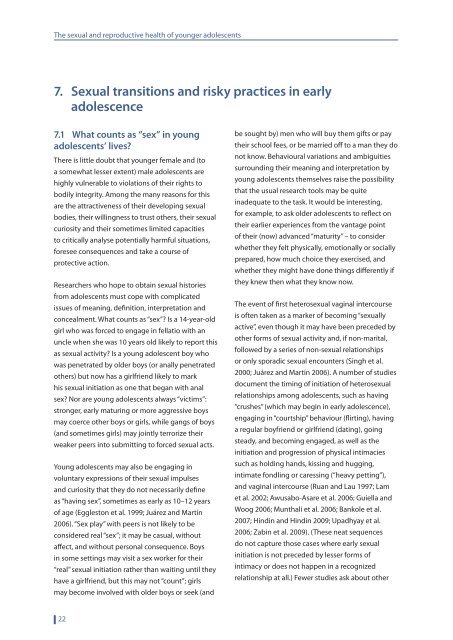The sexual and reproductive health of younger adolescents
The sexual and reproductive health of younger adolescents
The sexual and reproductive health of younger adolescents
You also want an ePaper? Increase the reach of your titles
YUMPU automatically turns print PDFs into web optimized ePapers that Google loves.
<strong>The</strong> <strong>sexual</strong> <strong>and</strong> <strong>reproductive</strong> <strong>health</strong> <strong>of</strong> <strong>younger</strong> <strong>adolescents</strong><br />
7. Sexual transitions <strong>and</strong> risky practices in early<br />
adolescence<br />
7.1 What counts as “sex” in young<br />
<strong>adolescents</strong>’ lives?<br />
<strong>The</strong>re is little doubt that <strong>younger</strong> female <strong>and</strong> (to<br />
a somewhat lesser extent) male <strong>adolescents</strong> are<br />
highly vulnerable to violations <strong>of</strong> their rights to<br />
bodily integrity. Among the many reasons for this<br />
are the attractiveness <strong>of</strong> their developing <strong>sexual</strong><br />
bodies, their willingness to trust others, their <strong>sexual</strong><br />
curiosity <strong>and</strong> their sometimes limited capacities<br />
to critically analyse potentially harmful situations,<br />
foresee consequences <strong>and</strong> take a course <strong>of</strong><br />
protective action.<br />
Researchers who hope to obtain <strong>sexual</strong> histories<br />
from <strong>adolescents</strong> must cope with complicated<br />
issues <strong>of</strong> meaning, definition, interpretation <strong>and</strong><br />
concealment. What counts as “sex”? Is a 14-year-old<br />
girl who was forced to engage in fellatio with an<br />
uncle when she was 10 years old likely to report this<br />
as <strong>sexual</strong> activity? Is a young adolescent boy who<br />
was penetrated by older boys (or anally penetrated<br />
others) but now has a girlfriend likely to mark<br />
his <strong>sexual</strong> initiation as one that began with anal<br />
sex? Nor are young <strong>adolescents</strong> always “victims”:<br />
stronger, early maturing or more aggressive boys<br />
may coerce other boys or girls, while gangs <strong>of</strong> boys<br />
(<strong>and</strong> sometimes girls) may jointly terrorize their<br />
weaker peers into submitting to forced <strong>sexual</strong> acts.<br />
Young <strong>adolescents</strong> may also be engaging in<br />
voluntary expressions <strong>of</strong> their <strong>sexual</strong> impulses<br />
<strong>and</strong> curiosity that they do not necessarily define<br />
as “having sex”, sometimes as early as 10–12 years<br />
<strong>of</strong> age (Eggleston et al. 1999; Juárez <strong>and</strong> Martín<br />
2006). “Sex play” with peers is not likely to be<br />
considered real “sex”; it may be casual, without<br />
affect, <strong>and</strong> without personal consequence. Boys<br />
in some settings may visit a sex worker for their<br />
“real” <strong>sexual</strong> initiation rather than waiting until they<br />
have a girlfriend, but this may not “count”; girls<br />
may become involved with older boys or seek (<strong>and</strong><br />
be sought by) men who will buy them gifts or pay<br />
their school fees, or be married <strong>of</strong>f to a man they do<br />
not know. Behavioural variations <strong>and</strong> ambiguities<br />
surrounding their meaning <strong>and</strong> interpretation by<br />
young <strong>adolescents</strong> themselves raise the possibility<br />
that the usual research tools may be quite<br />
inadequate to the task. It would be interesting,<br />
for example, to ask older <strong>adolescents</strong> to reflect on<br />
their earlier experiences from the vantage point<br />
<strong>of</strong> their (now) advanced “maturity” – to consider<br />
whether they felt physically, emotionally or socially<br />
prepared, how much choice they exercised, <strong>and</strong><br />
whether they might have done things differently if<br />
they knew then what they know now.<br />
<strong>The</strong> event <strong>of</strong> first hetero<strong>sexual</strong> vaginal intercourse<br />
is <strong>of</strong>ten taken as a marker <strong>of</strong> becoming “<strong>sexual</strong>ly<br />
active”, even though it may have been preceded by<br />
other forms <strong>of</strong> <strong>sexual</strong> activity <strong>and</strong>, if non-marital,<br />
followed by a series <strong>of</strong> non-<strong>sexual</strong> relationships<br />
or only sporadic <strong>sexual</strong> encounters (Singh et al.<br />
2000; Juárez <strong>and</strong> Martín 2006). A number <strong>of</strong> studies<br />
document the timing <strong>of</strong> initiation <strong>of</strong> hetero<strong>sexual</strong><br />
relationships among <strong>adolescents</strong>, such as having<br />
“crushes” (which may begin in early adolescence),<br />
engaging in “courtship” behaviour (flirting), having<br />
a regular boyfriend or girlfriend (dating), going<br />
steady, <strong>and</strong> becoming engaged, as well as the<br />
initiation <strong>and</strong> progression <strong>of</strong> physical intimacies<br />
such as holding h<strong>and</strong>s, kissing <strong>and</strong> hugging,<br />
intimate fondling or caressing (“heavy petting”),<br />
<strong>and</strong> vaginal intercourse (Ruan <strong>and</strong> Lau 1997; Lam<br />
et al. 2002; Awusabo-Asare et al. 2006; Guiella <strong>and</strong><br />
Woog 2006; Munthali et al. 2006; Bankole et al.<br />
2007; Hindin <strong>and</strong> Hindin 2009; Upadhyay et al.<br />
2006; Zabin et al. 2009). (<strong>The</strong>se neat sequences<br />
do not capture those cases where early <strong>sexual</strong><br />
initiation is not preceded by lesser forms <strong>of</strong><br />
intimacy or does not happen in a recognized<br />
relationship at all.) Fewer studies ask about other<br />
22
















